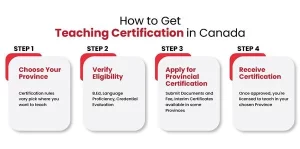Canada is welcoming teachers never than ever now! Teaching jobs in Canada are opening up in large numbers. This blog will catch you up on everything you need to know to make your move to Canada. The key step? Getting your teaching certification in Canada. We’ll break it down step by step.
Let’s go!
Table Of Content
1Are Teachers In Demand in Canada2How to Get Teaching Certification in Canada3Teaching Certification in Canada Requirements4Provincial Teaching Certificate Canada5Age Limit for Teachers in Canada6How to get Teaching License in Canada7IELTS Requirement for Teachers in Canada8Frequently Asked Questions
Are Teachers In Demand in Canada
Yes! Teachers are in demand in Canada, particularly in specialized areas such as STEM, special education, early childhood education, and French immersion. While urban centers like Toronto and Vancouver may be competitive, provinces including British Columbia, Alberta, Quebec, and the Atlantic regions are actively recruiting qualified educators.
Foreign-trained teachers must obtain provincial teaching certification in Canada, which may involve additional assessments or training. Immigration pathways like Express Entry and Provincial Nominee Programs (PNPs) offer strong routes to permanent residency, especially for candidates with job offers or in-demand skills. If you’re fluent in French or hold expertise in priority subjects, your chances of securing a teaching role in Canada are even higher. With the right support and certification, your dream teaching career in Canada could be just around the corner.
How to Get Teaching Certification in Canada
This step-by-step guide will help you understand how to get teaching certification in Canada. So here it is:
Step 1: Choose Your Province
Every province in Canada has its own teaching regulatory body. Your first step is to choose where you wish to teach.
Step 2: Verify Eligibility
- Qualifications: A Bachelor of Education (B.Ed) is needed (a 4-year degree in India).
- Language Proficiency: IELTS, CELPIP, or TEF (if French), by province.
- Get an Educational Credential Assessment (ECA): Have your foreign teaching degree evaluated by authorized bodies like WES (World Education Services) or ICAS (International Credential Assessment Service) to verify that it meets Canadian standards.
Step 3: Apply for Provincial Certification
Once you’ve confirmed your eligibility, the next step is to apply to the teaching regulatory body in the province or territory where you plan to work.
As part of your application, you’ll typically need to submit the following:
- Valid proof of identity (e.g., passport or birth certificate)
- Recent criminal background checks
- Academic transcripts and degree certificates
- Language proficiency test results
- Certified translations of documents (if not in English or French)
- Applicable application fees (varies by region)
Additional Requirements (If Needed)
Certain provinces or territories might enable you to start teaching with an interim or provisional license while making your way to full teaching certification in Canada.
For instance, in Alberta, you can receive an Interim Professional Certificate valid for three years. Once you have two years of satisfactory experience in teaching, you can then apply for a Permanent Professional Certificate.
Other provinces also have similar patterns, where one is fully certified after supervised or assessed classroom teaching for a while.
Step 4: Receive Certification
Once all requirements are met, you’ll be granted your teaching certificate/license, allowing you to work in schools in that province.
Teaching Certification in Canada Requirements
Teaching jobs in Canada are plentiful and promising. As we mentioned above in the blog, Canadian teaching certification has some minimum requirements. And as per the province you have selected, there might be some extra requirements as well; let’s see what those are:
Basic Eligibility
- Bachelor of Education (B.Ed) or equivalent
- Teaching license (if from home country)
- Language proficiency (IELTS CLB 7+ or TEF for French)
- Clean criminal record
- Credential evaluation
Additional Requirements by Province
| Province | Key Requirements |
|---|---|
| Ontario (OCT) | Pass the Ontario Teacher Qualifying Test (OTQT) (if required) |
| British Columbia (TRB) | Complete a Canadian teacher education program OR prove equivalent training |
| Alberta | An Interim Professional Certificate is issued for foreign-trained teachers (valid for 3 years) |
| Quebec | Fluency in French (minimum B2 level) is mandatory |
Provincial Teaching Certificate Canada
Teaching certification in Canada is provincially or territorially regulated, so you will need to be certified in the particular province or territory where you intend to teach. Every province and territory has its own separate regulatory agency, each with different qualification requirements and application processes. Following is which are they:
Age Limit for Teachers in Canada
No, there’s no age limit to be a teacher in Canada. Provided that you fulfill the teaching certification in Canada and the language requirements, you are free to teach at any age.
For immigration, age may impact your Express Entry points. For certification, provinces only consider qualifications and not age. In Canada, teachers usually retire between the ages of 60 to 65.
How to get Teaching License in Canada
To get a teaching license in Canada, you will need to go through a series of procedures, which slightly differ depending on the province or territory you wish to be employed in.
Typically, the process starts with possessing a recognized bachelor’s degree in education (B.Ed.) or equivalent qualification. If you have an foreign degree, you will probably be required to get your credentials evaluated by a recognized Canadian credential evaluation service like WES (World Education Services) or ICES. You may also need to take additional coursework or teacher training in Canada to comply with local standards.
After your education credentials are confirmed, you’ll be required to make an application to the teaching regulatory body in the province you’ve chosen. Your application will most likely include the submission of academic transcripts, documentation of English or French language skills (such as IELTS or TEF), a Clean criminal record check, and possibly documentation of current teaching experience. Certain provinces also ask that you pass certification exams or complete a supervised practicum.
After fulfilling all requirements, you’ll be granted a teaching certificate or license, which allows you to apply for teaching jobs within that province. It’s advisable to thoroughly research the specific requirements of the province you’re targeting.
IELTS Requirement for Teachers in Canada
Teaching jobs in Canada are booming, and to teach in Canada as a foreign-trained educator, you’ll likely need to prove your English proficiency, and IELTS is one of the accepted tests.
General IELTS Requirement
Most provinces demand the IELTS Academic version, a minimum of 6.5 to 7.0 overall, and no band score below 6.0. Provinces or territories may have slightly different requirements.
Frequently Asked Questions
- Choose the province you wish to work.
- Meet the eligibility requirements, like educational qualification, language, and extra requirements as per the province, if any
- Apply to the teaching regulatory organization in the province or territory.






